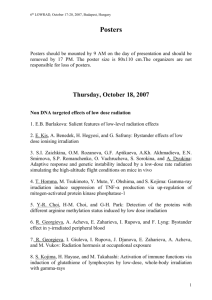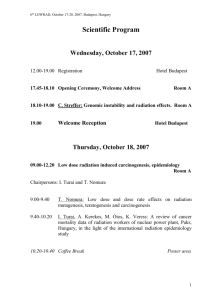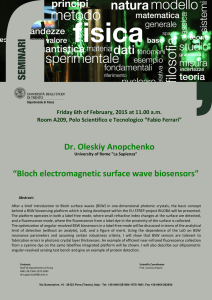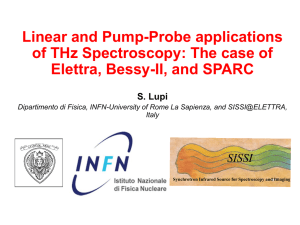Radiation Parameterization Principles
advertisement
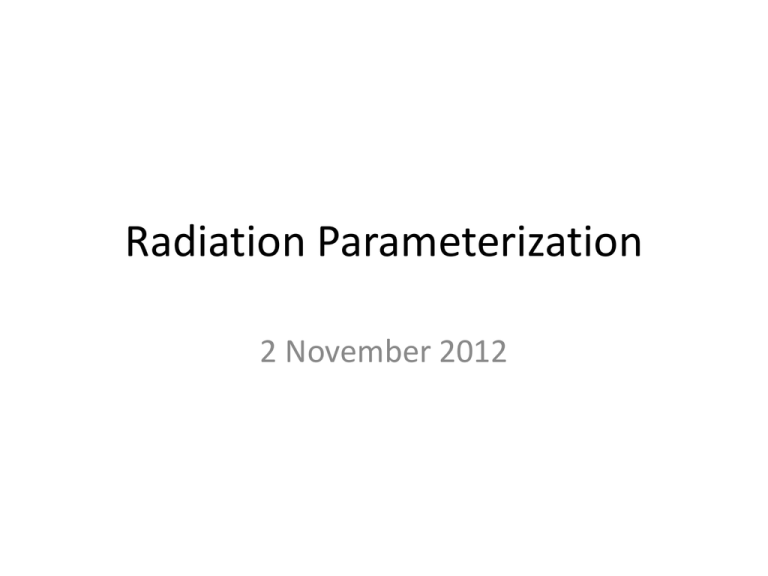
Radiation Parameterization 2 November 2012 Thematic Outline of Basic Concepts • Why is radiation important? • What are the fundamental processes that must be represented by a radiation parameterization? • How are radiative transfer processes handled within a radiation parameterization? • Where can more information be found regarding the specifics of radiation parameterization? Additional References Fundamentals of Atmospheric Physics by Murry Salby (Salby, M. L., 1996: Fundamentals of Atmospheric Physics. Academic Press, 627pp.) “The Parameterization of Radiation for Numerical Weather Prediction and Climate Models” by Graeme Stephens (Stephens, G. L., 1984: The parameterization of radiation for numerical weather prediction and climate models. Mon. Wea. Rev., 112, 826-867.) Why is Radiation Important? • The sun is the primary source of energy for the Earth. • Most of this energy comes in the form of radiation energy, often referred to as insolation. • Insolation, or more specifically spatial and temporal variability thereof, drives atmospheric circulations! – Hadley circulation; mid-latitude westerlies; tropics; etc. – Moist convection; coastal circulations; inversions; etc. Why is Radiation Important? • Insolation is a function of many different things… – Latitude and the seasonal cycle – Angle at which insolation intersects the Earth – Attenuation by the Earth’s atmosphere • A model must be able to accurately simulate how insolation interacts with land, oceans, vegetation, clouds, air molecules, and aerosols. – Implications: radiative heating and cooling of the Earth’s surface and the atmosphere Why is Radiation Important? • These interactions are typically parameterized by numerical models. • Important radiative transfer processes (scattering, absorption, etc.) occur on the molecular level. • Radiative transfer is complex… – Dependency upon a broad spectrum of wavelengths – Dependency upon numerous atmospheric constituents – Oftentimes considered over many distinct vertical layers, involving numerous calculations per layer Fundamentals of Radiation • There are four important processes to consider when attempting to describe radiative transfer… – Absorption: radiation energy absorbed by the surface and/or one or more atmospheric constituents – Scattering: radiation energy reflected by the surface and/or one or more atmospheric constituents – Emission: radiation energy emitted by the surface and/or by one or more atmospheric constituents – Transmission: radiation energy that is transmitted from space to the Earth’s surface (or vice versa) Fundamentals of Radiation • Energy transfer in the atmosphere involves radiation in two distinct bands of wavelength… – Shortwave: radiation emitted by the sun – Longwave: radiation emitted by the Earth’s surface and atmosphere • Their wavelengths differ as a function of the disparate temperatures of their respective emitters. Electromagnetic Spectrum (Image Source: Wikipedia) Fundamentals of Radiation • Relevant physics: Wien’s Displacement Law – Derived from Planck’s law – Relates the wavelength of maximum intensity to the temperature of a (blackbody/perfect) emitter… max 2897 m T (where T is in Kelvin) Fundamentals of Radiation • Effective solar temperature: ~6000 K – Wavelength of maximum intensity: 0.48 μm – Visible spectrum, corresponding to blue light • Solar radiation extends across the ultraviolet, visible, and near-infrared portions of the spectrum. – Peak between 0.36 – 0.75 μm – Range from 0.15 – 3 μm Fundamentals of Radiation • Incoming shortwave radiation is attenuated by a number of atmospheric constituents. • Ultraviolet radiation (λ < 0.3 μm) is absorbed at high levels associated with the photodissociation and photoionization of O2 and O3. • With the exception of narrow absorption bands of CO2 and H2O, however, most other shortwave radiation reaches the tropopause. Fundamentals of Radiation • In the troposphere, shortwave radiation (particularly in the infrared) is substantially absorbed. • Such absorption is primarily by H2O and CO2, absolute concentrations of which are large in the troposphere. • Most shortwave radiation reaching the surface is thus in the visible wavelengths, where the atmosphere is mostly transparent. Fundamentals of Radiation Irradiance: a measure of radiation energy flux (Salby, Figure 1.27) Fundamentals of Radiation • Mean temperature of Earth’s surface: 288 K – Wavelength of maximum intensity: 10 μm – In the infrared portion of the spectrum • Terrestrial radiation extends across the far-infrared to microwave portions of the spectrum. – Peak around 10 μm – Range from 5 – 100 μm Fundamentals of Radiation • Longwave radiation released by the Earth’s surface is almost completely absorbed by the atmosphere. – H2O, over a wide band centered at 6.3 μm – CO2, over a band centered at 15 μm, or near the peak of the longwave radiation emission spectrum – Trace gases (O3, CH4, N2O) at specific wavelengths • What is absorbed at some level is subsequently reemitted, with half directed upward and half directed downward. Fundamentals of Radiation • Most longwave radiation emitted by the Earth’s surface is absorbed in the troposphere. • Only a small amount of longwave radiation reaches beyond the tropopause. – Atmospheric Window: 8-12 μm – In this window, absorption is weak enough to permit longwave radiation to be transmitted to space. – Only notable absorber: O3, at 9.6 μm, in the stratosphere; associated with the greenhouse effect. Fundamentals of Radiation Fundamentals of Radiation • A couple of relevant definitions… – Albedo: Fractional amount of incoming solar radiation that is reflected and/or scattered back to space by the Earth’s surface, atmosphere, and clouds. – Emissivity: Fractional amount of radiation (per unit area per unit time) emitted by some emitter such as the Sun or the Earth’s surface. • Larger values reflect greater reflection and greater emission, respectively. Global-Mean Energy Budget (Salby, Figure 1.27) Global-Mean Energy Budget • The global-mean shortwave radiation flux at the top of the atmosphere is approximately 343 W m-2. – – – – 20% is absorbed by the atmosphere. 49% (169 W m-2) is absorbed by the Earth’s surface. 26% is reflected by the atmosphere. 5% is reflected by the Earth’s surface. • The 49% absorbed by the surface must be re-emitted to maintain thermal equilibrium, however. Global-Mean Energy Budget • The Earth’s surface emits more energy as longwave radiation than it absorbs as shortwave energy. – Mean surface temperature: 288 K – Stefan-Boltzmann law… F T 4 where ε = emissivity and σ = 5.67 x 10-8 W m-2 K-4 – For a blackbody emitter (ε = 1), F = 390 W m-2 Global-Mean Energy Budget (Salby, Figure 1.27) Global-Mean Energy Budget • Of the 390 W m-2 emitted by the surface, 84% (323 W m-2) is ultimately reabsorbed by the surface. • The balance between shortwave absorption and longwave emission and absorption leads to a net radiative heating of the surface of 106 W m-2. • For equilibrium, this is balanced by transfers of sensible and latent heat to the atmosphere. – Sensible: conduction with the atmosphere – Latent: evaporation off of the soils and oceans Incident Radiation Variability • There is substantial variability in the local shortwave radiation flux incident at the top of the atmosphere. – Latitude: highest at lower latitudes – Season: highest in local summer Incident Radiation Variability • There is also substantial spatiotemporal variability in the concentrations of atmospheric constituents that influence radiative transfer. – Concentrations of aerosols and other chemical compounds – Presence (or lack thereof) of clouds, precipitation, etc. • Furthermore, the Earth’s surface is non-uniform… – Topography: less atmospheric influence at higher altitudes – Land-surface: land vs. water, different soil types and land uses, etc. Radiation Parameterization • A radiation parameterization must be able to address such variability in the context of radiative transfer. • It must be able to accurately describe how radiation is absorbed, emitted, scattered, and transmitted within the entire model atmosphere. • Most radiation parameterizations will do this for longwave or shortwave radiation in terms of a radiation flux. Radiation Definitions • Intensity (Radiance): flow rate of energy in a given direction per a unit area at a given wavelength. • Flux (Irradiance): the amount of area-integrated intensity that is fluxed across a planar surface. • The total flux is the irradiance integrated over the electromagnetic spectrum. Absorption • In the absence of scattering, the absorption of radiation energy is expressed by Lambert’s Law: dI a ds I Iλ = intensity at a given wavelength ρ = mass per unit volume of the absorbing atmospheric constituent σaλ = mass absorption coefficient ds = an incremental distance Absorption • Integrating Lambert’s Law along the path that radiation travels over a short distance, we obtain: s I s I 0 exp a ds' 0 Iλ = intensity at a given wavelength (at s = 0 and s = 0) • The optical path length, or weighted dimensionless distance traveled by radiation, is given by: s u s a ds ' 0 Absorption • In the absence of scattering and emission, the transmissivity and absorptivity of a medium are related to the optical path length by: s e u s a s 1 e u s transmissivity absorptivity Emission • To maintain thermal equilibrium, a substance that absorbs radiation energy must also emit it. • The basis for describing thermal emission is the theory of blackbody radiation, where… – The emitted radiation is uniquely a function of the emitter’s temperature. – For a given temperature, the emitted radiation is the maximum possible at all wavelengths (perfect emitter). – Emitted radiation is isotropic, such that its intensity is independent of the direction of emission. Emission • The spectrum of intensity emitted by an absorbing medium is given by Planck’s Law: B T 2hc2 KhcT e 1 5 Bλ(T) = spectrum of emitted intensity h = Planck’s constant (6.6261 x 10-34 J s-1) K = Boltzmann constant (1.381 x 10-23 J K-1) c = speed of light Emission • The wavelength of maximum intensity is given by Wien’s Displacement Law, described earlier. • The total flux emitted by a blackbody follows by integrating Planck’s law over the entire spectrum, as expressed by the Stefan-Boltzmann Law. • For a non-blackbody emitter, Kirchhoff’s Law applies, where emissivity is equal to the absorptivity. Scattering • Scattering refers to the extraction and subsequent reemission of energy by matter. • Scattering is generally non-isotropic; radiation energy is scattered in wavelengths and directions different than those of the incident radiation. • Definition: mass scattering coefficient (σsλ), or the amount of radiation lost due to scattering. Scattering • A total mass extinction coefficient, combining the effects of absorption and scattering, can be defined: k a s • The extinction coefficient follows, i.e., e k • Lambert’s Law then holds with kλ in place of σaλ. – In reality, however, the non-isotropic nature of scattering makes things a bit more complex than the above. Radiative Transfer Equation • The general form of the radiative transfer equation is given by: dI I J k ds k λ = mass extinction coefficient I λ = intensity at a given wavelength Jλ = source function for intensity (equal to Planck’s Law) ρ = mass per unit volume of the absorbing atmospheric constituent(s) • This is integrated over many layers of incremental geometric thickness ds to assess radiative transfer. Radiation Parameterization • The aforementioned radiative processes are accounted for in calculations of the vertical fluxes of longwave and shortwave radiation at each grid point. • The vertical convergence of these fluxes is then employed in the thermodynamic equation, where… T 1 FD FU t cP z FD = downward flux of radiation energy FU = upward flux of radiation energy Radiation Parameterization • This is computed over all wavelengths at both the model surface and at all model atmospheric levels. • The challenge in radiation parameterization is a classic one: accuracy versus efficiency. – A radiation parameterization is generally not called each model time step because it is computationally intensive. – Accuracy is also strongly influenced by the coupled nature of atmospheric processes to radiation effects. Radiation Parameterization • Radiation parameterization requires accurate knowledge of both atmospheric state and nonroutinely observed molecular constituent fields. – Atmospheric state: temperature (Planck’s Law, Wien’s Displacement), water vapor concentration (H2O), etc. – Molecular constituents: particularly natural and anthropogenic aerosols (CO2, O3, CH4 etc.) • This poses particular challenges to climate models… – Accurate representation of aerosol radiative effects – Accurate knowledge of future aerosol concentrations Radiation Parameterization • Approximations to the radiative transfer equation for longwave and shortwave radiation are described in Sections 4.5.3 and 4.5.4 of the text, respectively. • These represent primarily empirical applications of the principles outlined earlier in this lecture. • For a more comprehensive description of radiation parameterization, see Stephens (1984, MWR).
